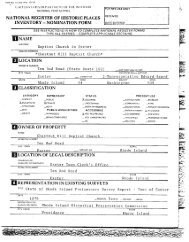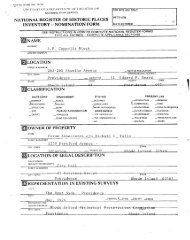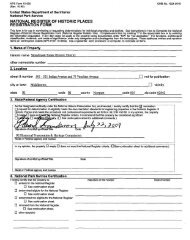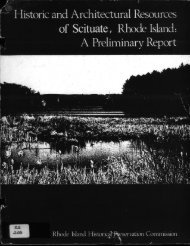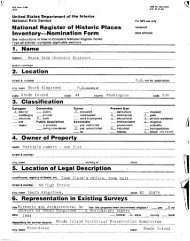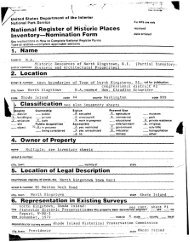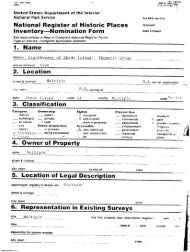National Register of Historic Places - Rhode Island Historical ...
National Register of Historic Places - Rhode Island Historical ...
National Register of Historic Places - Rhode Island Historical ...
You also want an ePaper? Increase the reach of your titles
YUMPU automatically turns print PDFs into web optimized ePapers that Google loves.
7. Description -.______________________<br />
Condition Check one Check one<br />
- - excellent deteriorated - unaltered 01 iqiflal site -<br />
N good ruins - X altered moved late<br />
fair unexposed<br />
Describe the present and original if known physical appearance<br />
Watch Hill, one <strong>of</strong> <strong>Rhode</strong> <strong>Island</strong>’s most attractive and best preserv-:’d<br />
coastal communities, developed as a seaside summer resort <strong>of</strong> hotels and<br />
substantial dwellings in the late nineteenth and early twentieth centur-..<br />
The village occupies a scenic shoreside expanse <strong>of</strong> hilly ground. The area<br />
is largely suburban in character, with an irregular pattern <strong>of</strong> streets con<br />
taining detached houses set on landscaped lots interspersed with woodland<br />
and lnarshland. The houses are executed in the various styles common in<br />
the decades immediately preceding and following the turn <strong>of</strong> the twenticl,h<br />
century. Nearly ninety percent <strong>of</strong> the 247 buildings in the district are<br />
residential structures, the’ majority built between 1840 and 1930. The<br />
relatively uni form scale and the predominant use <strong>of</strong> shingled wood- frame<br />
construction give Watch Hill a considerable degree <strong>of</strong> visual harmony.<br />
Watch Hill is situated at the extreme southwestern corner <strong>of</strong> <strong>Rhode</strong><br />
island in the town <strong>of</strong> Westerly, on a roughly triangular neck <strong>of</strong> land huinded<br />
southerly by Block <strong>Island</strong> Sound the Atlantic Ocean and northwesterly by<br />
Little Narragansett Bay and the Pawcatuck River, the last two <strong>of</strong> which f:orm<br />
the boundary between Westerly and Stonington, Connecticut. At the end <strong>of</strong><br />
the neck are two points: crescent-shaped Napatree Point, running <strong>of</strong>f to<br />
tiic: west, and Watch Hill Point, running <strong>of</strong>f to the south the latter the<br />
site <strong>of</strong> a lighthouse since 1808. - For ‘the most part the ocean sliorellic<br />
encompasses unbroken, gently curving stretches <strong>of</strong> sandy beach. ‘l’lie bay<br />
shore is more convoluted, with three small coves separating subsidiary<br />
pen i n Sn I as . The terrain at Watch Hi II is’ uneven * WI th a liutfihe r o f kIlo I I S<br />
depressions, and tiny ponds. The trees and shrubbery planted on house lots,<br />
the woods and vines on undeveloped parcels, and the tall reeds fill ing the<br />
marshes combine to create a strong countrified ambience. The changes in<br />
elevation and relatively dense vegetation separate the district visually<br />
into distinct subsections. The pattern <strong>of</strong> settlement, characterized by<br />
curving streets winding over and around the hillsides, is well suited to<br />
the picturesque landscape.<br />
- The primary route through the district -follows Watch Hill Road,<br />
Westerly Road, and Wauwinnet Avenue to Bay Street, the village’s main street<br />
Commercial activity is concentrated on Bay Street, a thoroughfare runnIng<br />
tangent to the shore <strong>of</strong> Little Narragansett Bay with a small waterfront<br />
park on one side. At its southwesterly end, Bay Street terminates at the<br />
i rig Horse Carousel, a local landmark listed in the <strong>National</strong> <strong>Register</strong> <strong>of</strong><br />
<strong>Historic</strong> <strong>Places</strong>. The earliest resort development occurred in the area<br />
adjoining Bay Street, Plympton Road, and L-shaped Bluff Avenue including<br />
Larkin Road, see district map , where the first hotels- -two <strong>of</strong> which sur<br />
vive- -and summer houses were built. Today this village center contains a<br />
mix <strong>of</strong> residential, commercxai ,-and institutional - structures, including<br />
the Watch Hill Chapel and the Post Office - The portions <strong>of</strong> the distiic t<br />
to the northeast are almost entirely residential. Though they were built<br />
up after 1885, these areas contain scattered remnants from eaTler periods,<br />
See Continuation Sheet #1








